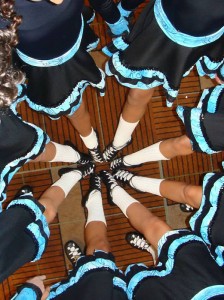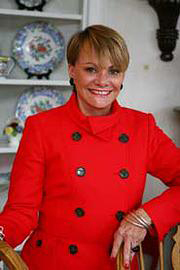In honor of the upcoming St. Patrick’s Day holiday (and because one of our themes this quarter is dance shoes) today we’re taking a closer look at shoes for Irish dance. We asked the well-known Chicago-area Irish dance instructor, Sheila Tully Driscoll to share some information about these shoes with us – and she was kind enough to oblige…

What are the main types of shoes are used in Irish step dance?
Irish dancers wear two types of soft shoes called Ghillies & Reel Shoes. Ghillies fit more like ballet slippers and are made of black leather, with a leather sole and a very flexible body. They lace from toe to ankle and do not make sounds against the dance surface. They are worn by female dancers for the light jig, the reel, the single jig, the slip jig, and group dances with two or more people.
The second kind of soft shoe is worn by male dancers – these are called “reel shoes” and are similar to jazz shoes in black leather, with fiberglass heels that can be clicked together while dancing. Some male dancers do not wear fiberglass heels. The men’s steps may be choreographed in a different style to girls’ in order to take advantage of the heels and to avoid feminine movements in steps.
Irish dancers also wear a pair of hard shoes, which are much bulkier and typically have fiberglass tips for a louder sound. dancers often refer to them as “Heavies” or Jig shoes. Both are traditionally made of black leather.
Do the shoes require breaking in, and if so, how is that typically done?
Hard shoes need breaking in by wearing them in as much as possible! Doesn’t matter if you’re walking, running, dancing, skipping – the shoes need to be worn in. Repeatedly bending the shoe also helps soften the leather. Some of the dancers use leather softener like Hot Glove cream.
Additionally, make sure the shoes fit CORRECTLY. Nothing is worse than an ill-fitting shoe! The shoes should have a snug fit at the start, allowing for possible stretching of the leather.

On average, how much do the shoes cost?
Soft shoes are around $90 and hard shoes around $180.
Can you share any interesting information about Irish step dance shoes in terms of their history?
The first hard shoes had wooden taps with metal nails. It was common practice in the 17th and 18th century to hammer nails into the soles of a shoe in order to increase the life of the shoe. Dancers used the sounds created by the nails to create the rhythms that characterize hard shoe dancing.
How important are the shoes to overall performance?
Since Irish dance is focused on rhythm and foot placement, it’s ALL about the shoes.
How young can an Irish Dancer start?
We start dancers around 5 years old although we have had a few younger dancers if they are ready.
What is some advice you would give to new dancers?
Anything new is hard. A lot of practice trains your mind, body and feet to move correctly and helps you practice timing as you learn to step to the beats. Also, you may be sore once you start dancing. Buy Sportscreme (or Flexall, or Icyhot, etc.) – its proven to be a lifesaver for many dancers! A little dab of Sportscreme after you dance takes all the pain away.

About Sheila Tully: As Founder and President of the Tully Academy of Irish Dance, Sheila Tully Driscoll has been teaching Irish Dance lessons for over 45 years. A champion Irish dancer herself, she began teaching Irish Dance in her mother’s basement while she was in college. Sheila received her T.C.R.G. designation (official Irish Dancing Teacher certification) in 1972 and her A.D.C.R.G. designation (official Irish Dancing Adjudication certification) in 1976. Today, she is the longest tenured Irish dancing teacher in the Chicago area and is highly regarded nationally and worldwide. She is a member of An Coimisian Le Rinci Gaelacha, the international governing body of Irish Dancing and adjudication as well as a member of the Irish Dance Teachers Association of North America and the Irish Dance Teachers Association of Mid-America. Taught by Pat Roche, one of the pioneers of Irish Dancing in Chicago, Sheila continues her hands on teaching in the classroom as well as participating as a judge at Irish dancing events.
Sheila’s Irish Dancing Academy, which opened its beautiful new studio in Glenview in 2003, is highly regarded in the Irish Dance community as her programs have produced many champion dancers and winning teams. Tully Dancers have successfully competed in many regional and national competitions as well as the World Irish Dance competition in Ireland. Her dancers have also performed all over North America entertaining a wide variety of audiences.
Visit our Website: www.tullyirishdancers.com




